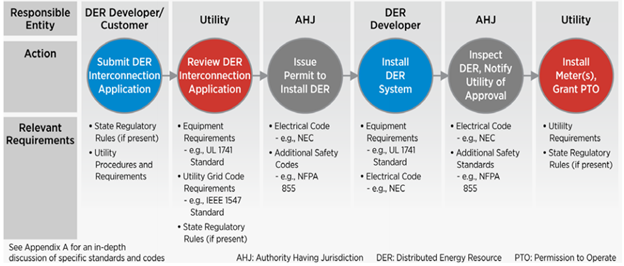Grid codes, interconnection, and safety
Skip to:
These requirements differ depending on where the system is connecting (e.g. transmission system, distribution system), the system size, how the system will operate, and other factors. For the transmission system, because the number of interconnections is fairly low and the size of each system is fairly large, the interconnection of storage systems is typically handled on a ‘case-by-case’ basis with much more scrutiny than can be afforded to smaller, more numerous distributed interconnections. That said, regulators can require specific elements for all transmission-interconnection agreements. For the distribution system, however, there may simply be too many individual interconnections to review individually in detail. Furthermore, smaller systems do not tend to have the same level of technical impacts as larger, transmission-level systems. Many utilities have already created frameworks to process interconnection requests for DPV interconnections, and these same or similar technical criteria and processes can be used to evaluate grid-tied energy storage systems (stand alone or connected to DPV), with some possible modifications depending on a system’s configuration, intended use case, and total export capacity.
Typical Distributed Energy Resource (DER) (including storage) Interconnection and Permitting Process

Source: The value of storage providing peaking capacity doubles
Reading List
Interconnection Standards, Application Management, and Technical Screening
National Renewable Energy Laboratory, 2020
In order to better manage how DER installations connect to the grid, utility interconnection procedures and technical requirements are being adapted to account for technology changes, emerging grid reliability issues, process-oriented bottlenecks, and evolving standards. This webpage addresses topics such as:
- Leading practices for improving DER interconnection
- Procedural automation options
- Addressing unique grid-design issues
- DER interconnection standards developments
- Energy storage interconnection issues
- The page lists key recent publications and webinars relevant to these topics.
An Overview of Behind-the-Meter Solar-Plus-Storage Regulatory Design
National Renewable Energy Laboratory, 2020
This report discusses designing a regulatory framework that aligns DPV-plus-storage deployment with larger policy objectives of the electric grid. The report covers the process of interconnecting DPV-plus-storage to the grid. This requires the development of regulations that govern interconnection, regulations on how DPV-plus-storage equipment is expected to perform, and how interconnection applications are screened and evaluated. Chapter 6 covers each of these regulation types in detail and suggests which agency types may be responsible for each step in the process.
National Renewable Energy Laboratory, 2021
This report presents global best practices of codes, standards, and interconnection procedures developed to support the safe and reliable deployment of battery energy storage systems BESS. Several relevant case studies highlight current efforts to ensure safe operation of BESS and showcase potential pathways for adoption of relevant codes and standards. Specifically, this report is intended to support the Thailand Office of Energy Regulatory Commission (OERC) and other stakeholders in their efforts to develop technical codes and standards to govern the installation and operation of BESS, but it may also be utilized as a guide for other countries as interest in the deployment of BESS technologies continues to grow.
National Renewable Energy Laboratory, 2019
As DER deployment grows, utilities and regulators must understand interconnection requirements for a given set of system characteristics, capabilities, and DER penetration level. This report discusses DER current interconnection approaches and their issues as well as evolving solutions to address challenges posed by DER interconnections. Chapter 9 focuses on interconnecting storage, which is unique in that it can act both as generation and load at different times. The report focuses on best practices for DER interconnection, and Chapter 9 includes how rules and levels of review for storage system interconnection should be designed among other unique issues.
Xcel Energy, January 2017
This document outlines electric storage interconnection guidelines for three different configurations:
- Case 1a: Stand-by energy storage — provision for facilities that require stand-by (backup) systems to provide power through onsite or grid-charged batteries.
- Case 1b: Parallel Operation without onsite generation — provision for batteries without onsite generation to operate in parallel with utility
- Case 1c: Parallel Operation with non-net metered, non-renewable onsite generation — provision for batteries with onsite generation to operate in parallel with utility.
To ensure compliance with interconnection rules and to prevent the unintended export of power to the grid in cases 1b and 1c, meters and the appropriate control systems must be installed and registered.
Example Interventions:
- Incorporating energy storage into interconnection processes, reducing uncertainty around their deployment behind-the-meter, and dictating how energy storage can charge and discharge.

